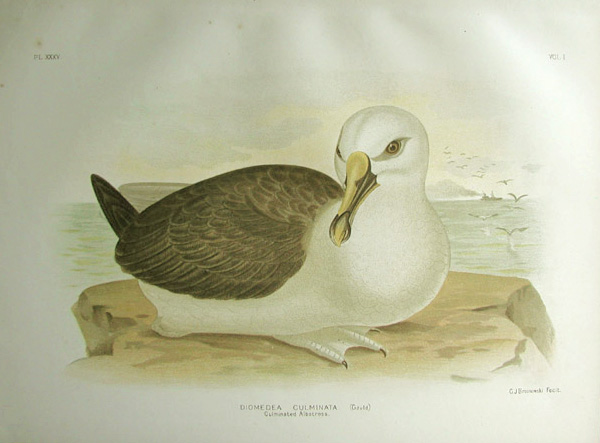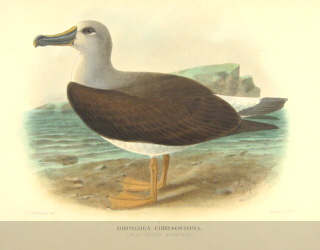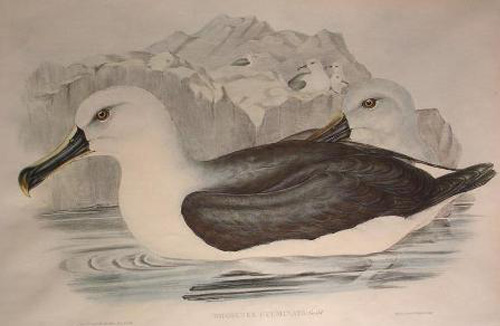


Grey_headed mollymawk, (DIOMEDEA CULMINATA) The Birds of Australia, 1887-1891, G.J. BROINOWSKI
In New Zealand seas, grey-headed mollymawks breed only at Campbell Island, where they intermingle with the black–browed mollys. They return to the island in early September. They are occasionally seen in New Zealand coastal waters and are one of the most frequently beached of the mollymawk species, especially in July–August when juveniles are moving north into the Tasman Sea. They tend not to congregate about fishing boats as most other mollymawks do.
However, recent research, comparing numbers from the 1940s and the 1990s on Campbell Island in the subantarctic, indicates a severe decline of the grey–headed mollymawk. Between the 1940s and 1990s there was a continuous 82%–88% decrease in nest numbers at three colonies. In the 1940s, there may have been as many as 43,000 grey–headed mollymawk nests per year. But in 1995–97, only 7800 were recorded, less than one–fifth over 50 years! The long–term decline is most likely caused by environmental changes that have an effect on the birds’ food supply. While longlining practices have improved considerably, the impact of the reckless bycatch of albatross in the 1970s and 1980s is still felt today, and the overall food supply for birds is down. Fortunately New Zealand fisheries are now developing methods that reduce the accidental capture of seabirds, but as albatrosses roam the southern oceans in their search for food, they also overlap with unregulated fisheries in international waters.


Grey_headed mollymawk, (DIOMEDEA CHRYSOSTOMA), The Birds of Australia 1910-28, Gregory Mathews.

Grey_headed mollymawk, Birds of Australia, 1840=48, John Gould
| Taxonomy | |
|---|---|
| Kingdom: | Animalia |
| Phylum: | Chordata |
| Class: | Aves |
| Order: | Procellariiformes |
| Family: | Diomedeidae |
| Genera: | Diomedea |
| Species: | chrysostoma |
| Sub Species: |
Diomedea culminata, Thalassarche chrysostoma
Native bird
80 cm., 3.25 kg., light grey head, throat, neck and mantle, sharp margin on chest to underparts, white rump, grey tail, upper wings and back dark grey, underwings white with black edges, bill black with yellow ridge and bottom edge, legs and feet, greyish white.
Occasionally seen in New Zealand coastal waters.
Soy el albatros que te espera en el final del mundo.
Soy el alma olvidada de los marinos muertos
que cruzaron el Cabo de Hornos
desde todos los mares de la tierra.
Pero ellos no murieron en las furiosas olas,
hoy vuelan en mis alas, hacia la eternidad,
en la última grieta de los vientos antárticos.
– Sara Vial. From an inscription on an albatross scupture at Cape Horn.
I am the albatross that awaits you at the end of the world
I am the forgotten soul of dead sailors who have rounded Cape Horn from
all the seas on earth.
They did not die in the roiling waves;
they fly on my wings
to eternity
along the last rift in Antarctic winds.
— Translation by Lisa Carter
G.J. BROINOWSKI, The Birds of Australia, 1887-1891,
Mathews, Gregory, The Birds of Australia 1910-28.
Gould, John, Birds of Australia, 1840=48.
Oliver, W.R.B. New Zealand Birds, 1955.
Heather, B., & Robertson, H., Field Guide to the Birds of New Zealand, 2000.
Conservation Science Newsletter No. 50, 28 February 2005.
Wednesday, 2 August, 2023; ver2023v1